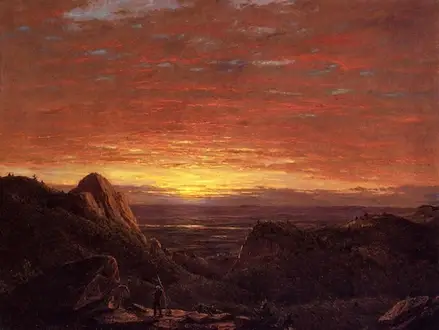Title of Artwork: “Morning, Looking East over the Hudson Valley to the Catskill Mountains”

Artwork by Frederic Edwin Church
Year Created 1848
Summary of Morning, Looking East over the Hudson Valley to the Catskill Mountains
Church’s early work, particularly the influence of Thomas Cole, is shown by this ethereal morning. In line with its Romantic roots, the song is understated yet meticulously crafted. A crescent-shaped crack in the stony landscape provides access to the Valley, where the Hudson River shimmers in the distance. There is a crimson glow in the sky, and a lone person stands in the foreground, facing the observer, like in previous European works like Caspar David Friedrich’s Wanderer over the Sea of Fog (c. 1818). He seems to be contemplating the vastness of the panorama before him. Because of his presence, the spectator is given an entry point into the scene, which helps to illustrate how nature can serve as a vessel for human aspirations and ambitions.
All About Morning, Looking East over the Hudson Valley to the Catskill Mountains
Upstate New York’s scenery was crucial to the development of the American school of landscape painting around Thomas Cole in the 1820s and 1840s. In order to prepare drawings for his work, Church’s artistic and spiritual mentor, Cole, had been visiting the Hudson Valley every year since 1825. Cole’s landscape paintings, such as The Oxbow (1835-6), capture the terrain in hyper-naturalistic detail while also serving as a symbol of all the promises and ambiguities of American colonial civilization. It’s no surprise that Church’s early landscapes, like those of Cole’s, deal with themes like Manifest Destiny. Using the interplay between the river plane below and the mountains above and beyond, this image offers several chances for spiritual or metaphorical reference.
The focus on atmospheric effects, which is mostly missing from Cole’s work, can be seen in pieces like Morning. This emphasis would become even more apparent in Church’s later sublime works. When he wrote this early work, he was still developing an American form of Romanticism, which is shown in his treatment of the American wilderness.
Information Citations
En.wikipedia.org, https://en.wikipedia.org/.






















